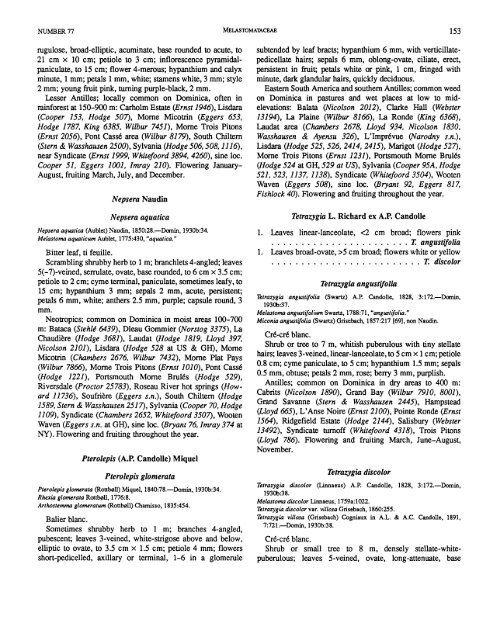Flora of Dominica, Part 2 - Smithsonian Institution Libraries
Flora of Dominica, Part 2 - Smithsonian Institution Libraries
Flora of Dominica, Part 2 - Smithsonian Institution Libraries
Create successful ePaper yourself
Turn your PDF publications into a flip-book with our unique Google optimized e-Paper software.
NUMBER 77 MELAsmMA~cEAE 153<br />
rugulose, broad-elliptic, acuminate, base rounded to acute, to<br />
21 cm x 10 cm; petiole to 3 cm; inflorescence pyramidalpaniculate,<br />
to 15 cm; flower 4-merous; hypanthium and calyx<br />
minute, 1 mm; petals 1 mm, white; stamens white, 3 mm; style<br />
2 mm; young fruit pink, turning purple-black, 2 mm.<br />
Lesser Antilles; locally common on <strong>Dominica</strong>, <strong>of</strong>ten in<br />
rainforest at 150-900 m: Carholm Estate (Ernst 1946), Lisdara<br />
(Cooper 153, Hodge 509, Morne Micotrin (Eggers 653,<br />
Hodge 1787, King 6385, Wilbur 7451), Morne Trois Pitons<br />
(Ernst 2050, Pont Casse area (Wilbur 81 79), South Chiltern<br />
(Stern & Wasshausen 2500), Sylvania (Hodge 506,508,1116),<br />
near Syndicate (Ernst 1999, Whitefoord 3894,4260), sine loc.<br />
Cooper 51, Eggers 1001, Imruy 210). Flowering January-<br />
August, fruiting March, July, and December.<br />
Nepsera Naudin<br />
Nepsera aquatica<br />
Nepsera aquatica (Aublet) Naudin, 185028.-hin, 1930b:34.<br />
Melastoma aq,uaticum Aublet, 1775430, "aquatica."<br />
Bitter leaf, ti feuille.<br />
Scrambling shrubby herb to 1 m; branchlets 4-angled; leaves<br />
5(-7)-veined, serrulate, ovate, base rounded, to 6 cm x 3.5 cm;<br />
petiole to 2 cm; cyme terminal, paniculate, sometimes leafy, to<br />
15 cm; hypanthium 3 mm; sepals 2 mm, acute, persistent;<br />
petals 6 mm, white; anthers 2.5 mm, purple; capsule round, 3<br />
mm.<br />
Neotropics; common on <strong>Dominica</strong> in moist areas 100-700<br />
m: Bataca (Stehle 6439), Dleau Gommier (Norstog 3373, La<br />
Chaudihre (Hodge 3681), Laudat (Hodge 1819, Lloyd 397,<br />
Nicolson 2101), Lisdara (Hodge 528 at US & GH), Morne<br />
Micotrin (Chambers 2676, Wilbur 7432), Morne Plat Pays<br />
(Wilbur 7866), Morne Trois Pitons (Ernst IOIO), Pont Casse<br />
(Hodge 1221), Portsmouth Morne Brules (Hodge 529),<br />
Riversdale (Proctor 25783), Roseau River hot springs (Howard<br />
11736), Soufriere (Eggers s.n.), South Chiltern (Hodge<br />
1589, Stern & Wusshuusen 251 7), Sylvania (Cooper 70, Hodge<br />
1109), Syndicate (Chambers 2652, Whitefoord 3503, Wooten<br />
Waven (Eggers s.n. at GH), sine loc. (Bryant 76, Imruy 374 at<br />
NY). Flowering and fruiting throughout the year.<br />
Pterolepis (A.P. Candolle) Miquel<br />
Pterolepis glomerata<br />
Pterolepis glomerata (Rottboll) Miquel, 1840:78.-Domin, 1930b334.<br />
Rhexia glomerata Rottbgll, 1776%.<br />
Arthostemma glomeratum (Rottboll) Chamisso, 1835454.<br />
Balier blanc.<br />
Sometimes shrubby herb to 1 m; branches 4-angled,<br />
pubescent; leaves 3-veined, white-strigose above and below,<br />
elliptic to ovate, to 3.5 cm x 1.5 cm; petiole 4 mm; flowers<br />
short-pedicelled, axillary or terminal, 1-6 in a glomerule<br />
subtended by leaf bracts; hypanthium 6 mm, with verticillatepedicellate<br />
hairs; sepals 6 mm, oblong-ovate, ciliate, erect,<br />
persistent in fruit; petals white or pink, 1 cm, fiinged with<br />
minute, dark glandular hairs, quickly deciduous.<br />
Eastern South America and southern Antilles; common weed<br />
on <strong>Dominica</strong> in pastures and wet places at low to midelevations:<br />
Balata (Nicolson 2012), Clarke Hall (Webster<br />
13194), La Plaine (Wilbur 8166), La Ronde (King 6368),<br />
Laudat area (Chambers 2678, Lloyd 934, Nicolson 1830,<br />
Wasshausen & Ayensu 326), L'Imprevue (Nurodny s.n.),<br />
Lisdara (Hodge 525,526,2414,2415), Marigot (Hodge 523,<br />
Morne Trois Pitons (Ernst I231), Portsmouth Morne Brules<br />
(Hodge 524 at GH, 529 at US), Sylvania (Cooper 95A, Hodge<br />
521, 523, 1137, 1138), Syndicate (Whitefoord 3504), Wooten<br />
Waven (Eggers 508), sine loc. (Bryant 92, Eggers 817,<br />
Fishlock 40). Flowering and fruiting throughout the year.<br />
Tetrazygia L. Richard ex A.P. Candolle<br />
1. Leaves linear-lanceolate, 5 cm broad; flowers white or yellow<br />
......................... T. discolor<br />
Tetrazygia angustifolia<br />
Tctrazygia angustifolia (Swartz) A.P. Candolle. 1828. 3:172.--Domin,<br />
1938:37.<br />
Melastoma angustifolium Swartz, 1788:71, "angustifolia."<br />
Miconia angustifolia (Swartz) Grisebach, 1857:217 [as], non Naudin.<br />
Cre-cre blanc.<br />
Shrub or tree to 7 m, whitish puberulous with tiny stellate<br />
hairs; leaves 3-veined, linear-lanceolate, to 5 cm x 1 cm; petiole<br />
0.8 cm; cyme paniculate, to 5 cm; hypanthium 1.5 mm; sepals<br />
0.5 mm, obtuse; petals 2 mm, rose; berry 3 mm, purplish.<br />
Antilles; common on <strong>Dominica</strong> in dry areas to 400 m:<br />
Cabrits (Nicolson 1890), Grand Bay (Wilbur 7910, 8001),<br />
Grand Savanne (Stern & Wusshuusen 2445), Hampstead<br />
(Lloyd 665), L'Anse Noire (Ernst 21 OO), Pointe Ronde (Ernst<br />
1564). Ridgefield Estate (Hodge 2144), Salisbury (Webster<br />
13492). Syndicate turn<strong>of</strong>f (Whitefoord 4318), Trois Pitons<br />
(Lloyd 786). Flowering and fruiting March, June-August,<br />
November.<br />
Tetrazygia discolor<br />
Tetrazygia discolor (Linnaeus) A.P. Candolle, 1828, 3: 172.-Domin,<br />
1938:38.<br />
Melastoma discolor Linnaeus. 1759a:1022.<br />
Tctrazygia discolor var. villosa Grisebach, 1860:255.<br />
Tetrazygia villosa (Grisebach) Cogniaux in A.L. & A.C. Candolle, 1891,<br />
7:721 .-Domin, 1930b:38.<br />
CrC-cr6 blanc.<br />
Shrub or small tree to 8 m, densely stellate-whitepuberulous;<br />
leaves 5-veined, ovate, long-attenuate, base
















